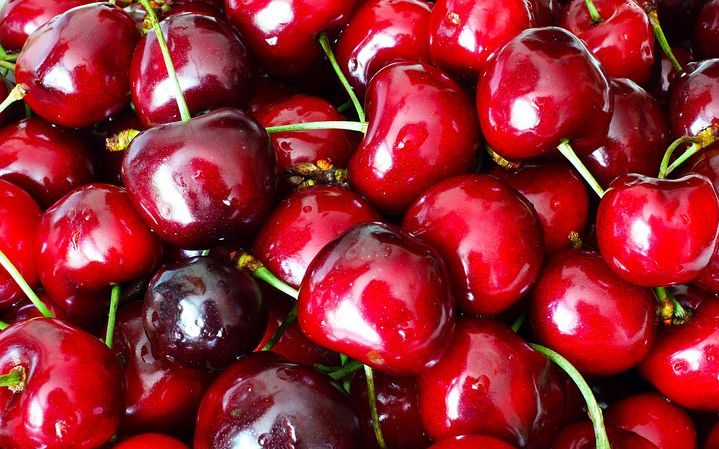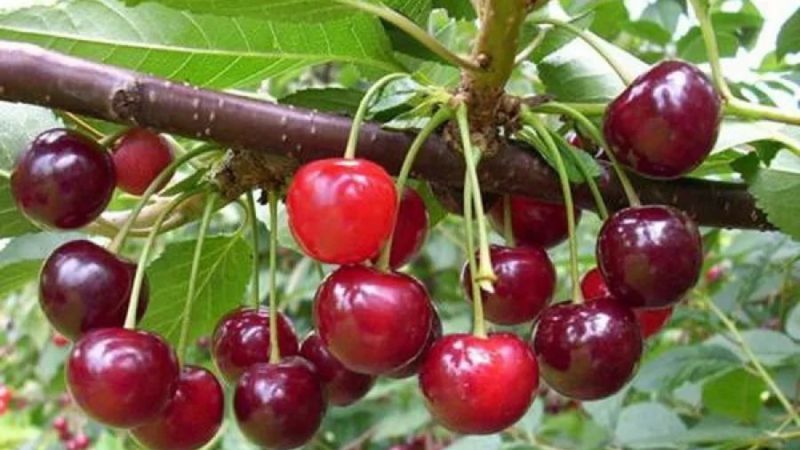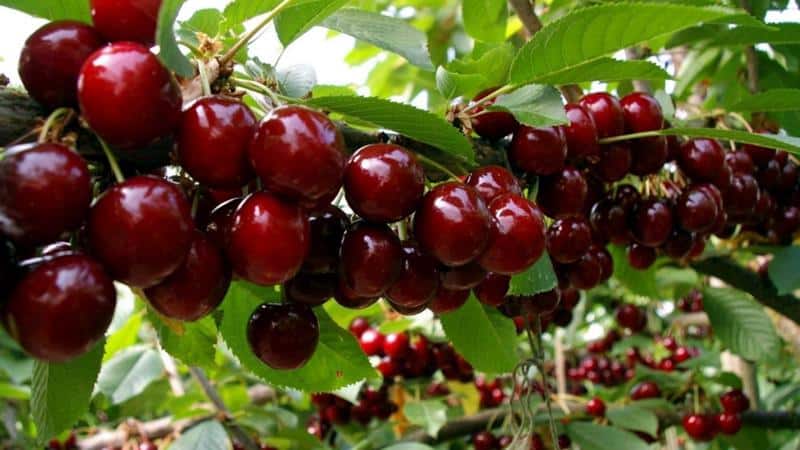The most productive and delicious varieties of cherries
When choosing varieties for the next planting, gardeners pay attention to care requirements, plant resistance to disease, and the marketability and taste of the fruit. It is important to determine in advance for what purpose the crop is grown. It is recommended to plant late-yielding varieties for sale, and early-ripening and easy-to-care varieties for fresh consumption. Let's look at the best varieties of cherries, their characteristics, productivity indicators and growing rules.
Types and varieties of cherries
Varieties are classified according to ripening time - early, mid-ripening and late. There are also low-growing and weeping varieties - depending on the shape and size of the crown. The correct choice of variety affects the yield, taste and size of the fruit. When purchasing a seedling, it is recommended to study the characteristics and features of the variety and prepare the garden soil and planting site in advance.

Frost resistant
Frost-resistant varieties of cherries can withstand temperatures as low as -30°C. Such varieties are grown in regions with unstable climate and cold weather - in the Urals, Siberia and the Far Eastern region.
Bystrinka
Bystrinka cherry can withstand frosts down to -45°C. Partially self-fertile, unpretentious to grow. The height of the tree is up to 2.5 m, the crown is semi-spreading. The berries are round, weight - 3.6 g, taste balanced sour-sweet. The harvest is used to make preserves, compotes, tinctures, and jams.
Radonezh
The early-fruiting, medium-late variety Radonezh begins to bear fruit in the fourth year after planting.The berries have attractive commercial qualities - round, with a burgundy glossy skin. Weight - about 4 g, the flesh is dense, the taste is sweet and sour. Tasting score: 4.2 points. Radonezh cherries are resistant to insect pests and rarely suffer from coccomycosis and powdery mildew. Is immune to drought.
Sverdlovsk resident
The frost-resistant variety is unpretentious in cultivation and is suitable for the Urals and Siberia. The weight of the fruit is about 3 g, the shape is round. The peel is burgundy, glossy. The yield per tree is about 10 kg per summer. The taste is sweet and sour, pleasant. Sverdlovsk cherries are universal in application.
Self-fertile
Self-fertile cherries do not require cross-pollination or pollinating insects. The tree bears fruit annually and is distinguished by its productivity. Self-fertile varieties are especially popular among amateur gardeners.

Apukhtinskaya
Apukhtinskaya cherry bears fruit in the second year after planting. The height of the tree is from 3 to 7 m, the crown is oval. The fruits are dark red, round-heart-shaped, weight - up to 4 g. The oval stone is easily separated from the sweet-tart pulp. Apukhtinskaya ripens at the end of summer, the yield is about 12 kg per tree. The variety is unpretentious in care, but it is recommended to pay attention to protection from diseases - regularly spray the plants with the preparation "HOM".
Lebedyanskaya
The tree is fast-growing, medium-sized. The fruits are heart-shaped and round, weighing about 5 g. The color is dark red, attractive, with a glossy tint. The pulp is tender and juicy, of medium density. Lebedyanskaya cherries are good in fresh, frozen, or dried form. The plant is planted in the southern regions with fertile lands - cherries need nutrition, sun and warmth. Frost resistance is average.
Farmer
Mid-season self-fertile variety. The weight of the fruit is about 3.4 g, the shape is round-oval, the color is dark burgundy.The pulp is homogeneous, the juice is dark. The taste is sweet, with a pleasant tartness. The farmer begins to bear fruit 3-4 years after planting. Productivity - from 10 to 17 kg per tree - depends on the growing region. The fruits are transportable and have commercial qualities.
Low-growing (dwarf)
Dwarf cherry trees decorate any area - they look original and take up little space. Summer residents also plant low-growing cherries as hedges, instead of concrete and brick fences.

Ashinskaya
Tree height - 2.5 m, leaves of medium length, conical crown. The fruits are round-oval, weighing up to 4 g. The skin is glossy, the color is dark burgundy. The pulp is red, juicy, the taste is sweet and sour. The small bone is easily separated from the pulp. Ashinskaya cherry blossoms after May 20, the harvest is harvested in late July or early August. Cherry is resistant to coccomycosis and drought, and is unpretentious in care.
Abundant
The bush is compact, height - 2.5 m, oval crown. Late variety - blooms at the end of May, bears fruit in the second ten days of August. The weight of dark red berries is 2 g, the shape is round-oval. The pulp is tender and juicy, the taste is sweet and sour. The cherries do not crack; the harvest is used for processing and sale. Izobilnaya cherries are valued for their marketable qualities and extended fruiting period - they harvest in 2-3 stages.
Interesting! Gardeners in the middle zone plant Anthracite cherries on the plot. The plant is easy to care for, the fruits are sweet and universal in use. Taste quality is rated 4.9 out of 5.
Zagoryevskaya
Compact trees are easy to care for. The crown is spreading and wide. The weight of the berry is about 4 g; Zagoryevskaya looks like a cherry. The taste is sweet and sour, dessert. The juice is thick and burgundy. The stone is easily separated from the pulp.Productivity is about 14 kg per plant. During harvesting, the fruits do not fall off, the variety is drought-resistant. The variety is planted in Moscow and the Moscow region.
Octave
The crown is round, compact, tree height is 2-3 m. The fruits are dark cherry, average weight is 3.9 g. The color is burgundy-black, shiny. The peel is dense, so the crop is shelf-stable and transportable. The bone is round, small, and comes off easily. Flower buds are frost-resistant, so Octave cherries are grown in the middle zone.
Weeping
Weeping cherries are planted in spacious areas - the drooping, spreading crown requires a lot of free space. Such trees are unpretentious in care - you do not need to waste time on pruning and shaping.
Shubinka
The tree is vigorous, the crown is of medium density. The fruits are round-flat, weight - 2.5 g. The peduncle is long, the peel is burgundy, thin. The pulp is medium-density, burgundy, loose. The taste is sour, the stone is small. The advantages of Shubinka cherries include frost resistance, the disadvantages are sour taste, average immunity to diseases.
Hope
The height of the tree is up to 6 m, the crown is wide-pyramidal, drooping. The shoots are fast growing, the internodes are long. The fruits are round-oval, weight - up to 6 g. The pulp and juice are dark red. Taste sweet with pleasant sourness and rich cherry aroma. There is no astringency or bitterness. Nadezhda cherries ripen in late June or early July and bear fruit 4-5 years after planting. Productivity is from 9 to 15 kg of berries per year. From the description of the Nadezhda cherry variety it follows that winter hardiness and drought resistance are average.
Most productive

Yield varieties of cherries are planted by summer residents and farmers.Some of the berries are used fresh, some are sent for processing - compotes and jam are prepared, added to baked goods or canned whole with other berries and fruits. If the berries have a thick skin, then they are grown for sale - stored in boxes and transported over long distances.
Memory of Vavilov
The tree is fast growing, the shoots are curved, the leaves are dark green. The fruits are one-dimensional, weight 3-4 g, heart-shaped. The rind is dark burgundy, the pit is cream-colored. The variety is self-sterile; it is recommended to plant other cherry varieties nearby. The ripening period is the end of July, the yield is 16-22 kg per bush per season. The tree bears fruit in the fourth year after planting.
Parental
Subject to agrotechnical rules, Parental yields from 20 to 25 kg of harvest annually. The fruits are flat-round, weight - 3 g, burgundy color. The pulp is dessert, sweet and sour, the juice is thick, dark red. Parent fruit bears fruit for 2-3 years. Parent cherry is planted mainly in central Russia. In the north, the buds will freeze, which will negatively affect the reduction in yield.
Ksenia
Partially self-fertile variety. The fruits are large, weight - from 7 to 10 g, round shape. The berries are burgundy, glossy. Fruiting occurs in mid-June - the harvest is harvested in two stages. The taste of Ksenia cherries is sweet and sour, harmonious, with a rich cherry aroma. Productivity - up to 25 kg per tree. Advantages include frost resistance - Ksenia can withstand temperatures down to -25°C.
Ural cherry
Compact trees occupy little space on the site and bear fruit on loamy and sandy loam soils. The Ural cherry begins to bear fruit in the third year after planting. The weight of the berry is 5 g, the shape is wide-round, the consistency is soft. The taste is sweet with sourness, harmonious.The lift from the footrest is easy, the bone is small. The variety is partially self-fertile and has average resistance to drought.
Interesting! For long-term storage, cherries are harvested 10 days before full ripening. The berries are not washed, put in wooden boxes and put in a dry, dark place.
Early

Early ripening cherries are grown in regions with short and cool summers. The harvest is harvested in July; the fruits are not inferior in taste and marketability to mid-season and late varieties.
Sap
The self-sterile variety Zhivitsa begins to bear fruit 4-5 years after planting. The first harvest is harvested at the end of June. The berries are dark red, weight - 3.8 g. Zhivitsa is duk - hybrid of cherry and sweet cherry, so the fruits have a sweet and juicy taste. The bone comes off easily.
Garland
Cherry Garland ripens at the end of June. The weight of the fruit is up to 6 g, the shape is heart-shaped and round. The pulp is bright red, the taste is sweet and sour. The tree is low-growing, 3 m high, the shoots are straight. Resistance to coccomycosis is average, immunity to diseases is strong. Desserts and baked goods, drinks and jam are prepared from cherries. The yield of the variety is about 25 kg per plant.
Bottle
The height of the tree is from 2.5 to 3 m, the crown is spherical. The berries are round or flat-round, weight up to 3 g. The color is red-pink, original. The peel is dense and slightly bitter. The pulp is very juicy, pink, with veins. The stone is small and easily separated from the pulp. The taste is classic cherry, pleasant and refreshing. The variety is self-sterile, frost resistance is average, the harvest is harvested in late June or early July.
Late
Late-ripening cherries ripen in August. The berries are large and juicy, the pulp is sweet and sour, harmonious. Late varieties need special care - summer residents regularly fertilize the soil superphosphate and manure, spray the trees with a solution of Bordeaux mixture to protect against pests.

Putinka
The height of the tree is up to 3 m, the crown is thick and drooping. The weight of the fruit is 5-7 g, the shape is wide-round, the peel is glossy, burgundy. The pulp is juicy, dark red, the taste is sweet and sour. Tasting score - 4.6 points out of 5. Putinka is planted in mid-April, the seedlings are sensitive and need nutritious soil. Frost resistance is average, the variety is resistant to coccomycosis.
Vyanok
A fast-growing variety with mid-late ripening period. Winter-hardy, unpretentious in care. The fruits are round, weight - 3-4 g, color burgundy-red. The pulp is medium dense, juicy. The taste is sweet and sour, balanced. The harvest is used fresh, frozen and dried. The fruits do not fall off during harvesting and do not crack.
Winter pomegranate
A self-fertile late-ripening variety ideal for growing in Siberia. Disease resistant, blooms in May, harvested in August. The tree is dwarf, height - up to 2 m. Fruit weight - about 4 g, color burgundy-red. Productivity - up to 10 kg per tree per season. Winter Pomegranate is universal in use.
The best varieties of cherries for the Nizhny Novgorod region

For landing in the Nizhny Novgorod region, gardeners choose frost-resistant varieties for planting so that cherries are not damaged by precipitation, winds and sudden temperature changes. One of these varieties is Zvezdochka cherry. It can withstand temperatures down to -38°C and is unpretentious in cultivation. The root system is developed and powerful - the tree independently provides itself with moisture. The asterisk is resistant to diseases and insects. The fruits are round, scarlet in color, weight - 4-5 g. The pulp is tender and aromatic, the taste is sweet and sour. Zvezdochka blooms in May, harvested in June-July.
Another variety for planting in the Nizhny Novgorod region is the memory of Enikeev. The ripening period is the end of June, the yield is from 8 to 15 kg per plant. Plant height is 3 m, the fruits are large, heart-shaped. The pulp is sweet and juicy. Taste qualities are rated 4.8 points out of 5. The purpose is universal, delicious jams and preserves are made from cherries, the fruits are frozen for the winter and cooked into compotes.
Attention! Gardeners recommend paying attention to the Raspletka variety. Cherries tolerate drought and frost and rarely get sick. The height of the tree is about 2.5 m, the lifespan of the tree is about 15 years. The berries are dark burgundy, weight about 4 g. Variety highly self-fertile, does not require pollinating neighbors or insects. The berries ripen by the end of July.
Conclusion
The most productive cherry varieties are Parental, Memory of Vavilov, and Ural cherry; the most frost-resistant are Bystrinka, Radonezh, Sverdlovchanka. Dwarf varieties stand out among all - Ashinskaya, Izobilnaya, Oktava. The height of the bushes is no more than 3 m, they look original and decorate the area. Before planting, it is recommended to read reviews from other gardeners and study the information on the packaging. When choosing, it is important to know the ripening period of cherries. Early fruits are harvested at the end of June, late ones - in August.